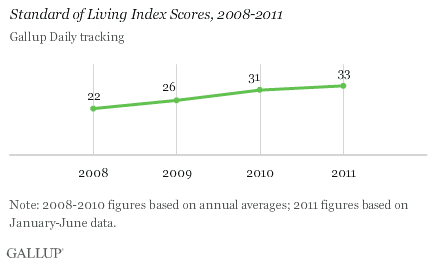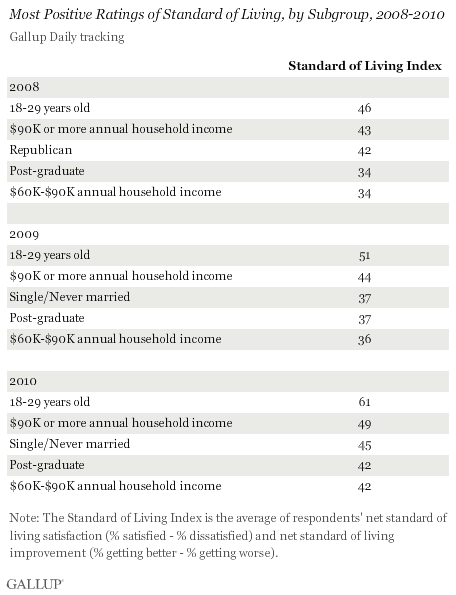PRINCETON, NJ -- Young adults are most positive about their standard of living, followed by those living in upper-income households, among key subgroups. At the other end of the spectrum, those who are unemployed, divorced, separated from their spouse, or living in lower-income households are least positive about their standard of living.

In general, the groups rating their standard of living most positively are either young or have high socioeconomic status (upper income or high educational attainment). The groups with the least positive outlooks tend to be lower income or have had marital difficulties. Those who are close to retirement age (50- to 64-year-olds) also rate their standard of living more negatively, perhaps out of concern about funding their retirement, which is Americans' top financial worry.
The standard of living results by subgroup for January-June 2011 are shown on page two of this article. These are based on Gallup Daily tracking interviews with 102,390 U.S. adults. Each subgroup has at least 1,800 respondents, with most having more than 10,000.
Standard of Living Ratings Trending Upward
Gallup's national average Standard of Living Index score for 2011 to date is +33. That represents the average of the net satisfaction score of +51 (75% satisfied vs. 24% dissatisfied) and net improvement score of +15 (48% say their standard of living is getting better and 33% say it is getting worse).
The 2011 index scores to date are somewhat more positive than Gallup measured in 2008, 2009, and 2010.

Both dimensions of the Standard of Living Index have improved since 2008, with net satisfaction ratings increasing from +43 to +51, and net improvement ratings going from 0 to +15.
Most, Least Positive Subgroups Have Been Consistent in Past Four Years
Although standard of living evaluations have improved in recent years, the groups ranking among the most and least positive have been remarkably consistent. Younger and upper-socioeconomic status Americans have ranked as the most positive groups since 2008, with all these groups' scores rising over the past four years. The one exception is Republicans, who ranked in the top five in 2008, but have not been among the highest groups since.

Unemployed Americans had the least positive evaluations of their standard of living in 2010 as well as in 2011 so far. Gallup did not measure unemployment status prior to 2010. Aside from unemployment, the groups with the least positive outlook on their living standards have been lower income, divorced, separated, and near-retirement age Americans. Like the most positive groups, the least positive groups' ratings have improved since 2008.
Democrats placed in the bottom five in 2008. That suggests these ratings are to some degree influenced by politics, as Democrats' ratings have improved, and Republicans' have worsened, since President Obama took office.

Implications
Young Americans have consistently been the most positive about their standard of living since Gallup began tracking Americans' ratings of it in 2008. That may not necessarily reflect their financial reality, since younger Americans in general have lower incomes than those in their middle age. Young adults may not have as high an income as older Americans, but they also in many cases may not have the same financial responsibilities, such as a mortgage or children. Many young adults also still receive some financial support from their parents. Young adults' more positive standard of living evaluation may also reflect youthful optimism about their economic future, with many young Americans entering the workforce, establishing their careers, or furthering their education in the hopes of doing so.
By the time Americans reach their 50s, that optimism apparently fades, given that 50- to 64-year-old Americans have consistently been among the groups least enthusiastic about their standard of living.
Besides the age and political differences observed in recent years, Americans' assessments of their standard living generally reflects their current economic situation.
Survey Methods
Results are based on telephone interviews conducted as part of Gallup Daily tracking Jan. 2-June 30, 2011, with a random sample of 102,390 adults, aged 18 and older, living in all 50 U.S. states and the District of Columbia.
For results based on the total sample of national adults, one can say with 95% confidence that the maximum margin of sampling error is ±1 percentage points.
Margins of error for subgroups have a maximum margin of sampling error of ±3 percentage points.
Interviews are conducted with respondents on landline telephones and cellular phones, with interviews conducted in Spanish for respondents who are primarily Spanish-speaking. Each sample includes a minimum quota of 400 cell phone respondents and 600 landline respondents per 1,000 national adults, with additional minimum quotas among landline respondents for gender within region. Landline telephone numbers are chosen at random among listed telephone numbers. Cell phones numbers are selected using random digit dial methods. Landline respondents are chosen at random within each household on the basis of which member had the most recent birthday.
Samples are weighted by gender, age, race, Hispanic ethnicity, education, region, adults in the household, and phone status (cell phone-only/landline only/both, cell phone mostly, and having an unlisted landline number). Demographic weighting targets are based on the March 2010 Current Population Survey figures for the aged 18 and older non-institutionalized population living in U.S. telephone households. All reported margins of sampling error include the computed design effects for weighting and sample design.
In addition to sampling error, question wording and practical difficulties in conducting surveys can introduce error or bias into the findings of public opinion polls.
For more details on Gallup's polling methodology, visit www.gallup.com.

